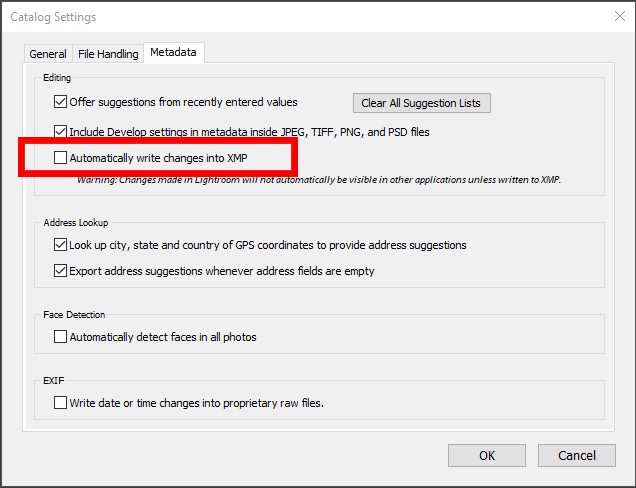Is Lightroom Slow for You? 5 Lightroom Performance Fixes

Adobe Lightroom Classic CC is used by photographers every day to touch up and edit their pictures. When the software starts running slowly, it really hampers your workflow and can make the activity of editing and organizing your photos a chore. Today we will be talking about 5 ways you can speed up Lightroom performance, so you can get back to editing!
1. Audit Your Hardware

Sometimes it’s not the software, but the hardware. Double-check that your machine is powerful enough to run Lightroom. If you work with larger, more complex files, then you will need more powerful hardware. Adobe recommends that your computer has at least 12 GB of RAM. Higher RAM will speed up importing and exporting, as well as your workflow with panoramas or HDR images. For file storage, a typical SATA hard drive will be sufficient. Obviously having a solid state drive will speed things up. If you must use an external hard drive, make sure that you use a Thunderbolt or USB-3 connection for fastest speeds. Also make sure that your hard drive has enough free space. If there isn’t enough free space, it can perform slowly, so try to keep at least 20%-25% free space on the drive you store Lightroom and its project files on.
Having a good graphics card will be useful as well. Even if you don’t have a dedicated graphics card, and only have an integrated one, your computer should be able to run Lightroom. But having a dedicated card with at least 1 GB of VRAM will greatly increase your performance. Adobe keeps a list of recommended GPUs for Lightroom. If you have a monitor with a high pixel count, this will also be a draw on the software, as it needs to update each pixel when you make a change. Reduce your screen resolution if you need to.
If you are lacking in the hardware department, consider upgrading your computer, or certain aspects of it.
2. Update Your Software

Always keep your software up to date. Firstly, this includes Lightroom itself. Updates from Adobe fix bugs and increase performance, and may clear up issues you’re having. Unfortunately, updates to Lightroom don’t always come with a performance boost, and many users report the program running slower. However, it is still generally worth it to upgrade, since the updates come with compatibility and stability fixes.
Keeping your operating system updated is also important to the general performance of your computer. This also applies to your graphics card software, and any graphics-related drivers. These upgrades will come with compatibility fixes and increased stability, and will only improve your Lightroom experience.
If you have a 64-bit system, you should also make sure that Lightroom is running the 64-bit version. It should do this by default, but there is always room for something to go wrong.
Other good upkeep items in general are to close other programs when working in something intensive like Lightroom, defragment your hard disk, and run Disk Cleanup if you’re on Windows. These activities will help remove the clutter from your computer and make it run smoother.
3. Control Your Preview Files

Lightroom creates preview images of your projects, and these can slow down the program. Lightroom needs 1:1 previews, but this can be a drain on your system. You can change when your images render so that they don’t take up processing power while you’re working.
File Handling in Lightroom
You can choose to render on import by using the File Handling panel on the import window. Just select 1:1 as your Render Preview. This will slow down the import process greatly, but will speed up the software when you’re working. Do this if you can, such as the night before you want to work on the images. You can alternatively choose to render minimal or standard previews while importing, and only do a 1:1 render on files when you’re ready to use them. This will be more useful if you have to import thousands of images and want to start working on them as soon as possible, or maybe only want to work on specific images.
If you use standard previews, you can go into the File Handling settings and change the preview quality to low or medium. When using 1:1 previews, try to keep them as long as you can. Lightroom deletes and re-creates previews at regular intervals, and this takes up valuable processing power. If you need, change the File Handling settings to automatically discard 1:1 previews every 30 days, or even never. Keep an eye on this file though, as it can grow large if left unchecked.
4. Increase the Cache Size

Sometimes increasing the Camera Raw cache can help speed up Lightroom slow-downs. When you view or edit an image, Lightroom updates a high-quality preview. The process speeds up if the original image is in the Camera Raw cache. And the bigger the cache, the more of these images it can store. The cache is set to 1 GB by default, but you can increase it to 20 GB or higher if you’re taking a couple thousand images in a shoot. To adjust the cache size, find Camera Raw Cache Settings in the File Handling settings and change the cache size.
You should also make sure that the cache is located in an optimal place. If possible, keep your cache on an internal hard drive separate from the drive your OS is on. However, avoid using an external drive, as this will slow things down. It is also important that if you move the cache, you also move the catalog to the same place. If you don’t, Lightroom will have to re-create previews, which as we know will take more processing power!
5. Turn off Autowrite XMP

The majority of people do not need Lightroom to save XMP data. XMP data is a record of metadata based on changes you make to your Lightroom files. You really only need this information if you want programs like Adobe Bridge and Camera Raw to recognize your edits. Turning this off will save you some processing power, since normally Lightroom would be constantly writing to this file every time you make an edit!
You can change this setting by opening your Catalog settings and navigating to the Metadata tab. There you will find a checkbox to automatically write changes into XMP. If you still want this data, you can manually use Save Metadata to File whenever you want.
If Lightroom runs slowly, try some of these performance enhancing tips! When you’re working with thousands of photos, you want to do everything that you can to improve your workflow. The good news is, Adobe is always trying to improve their products. If you have any other tips for Lightroom users, let us know in the comments.








